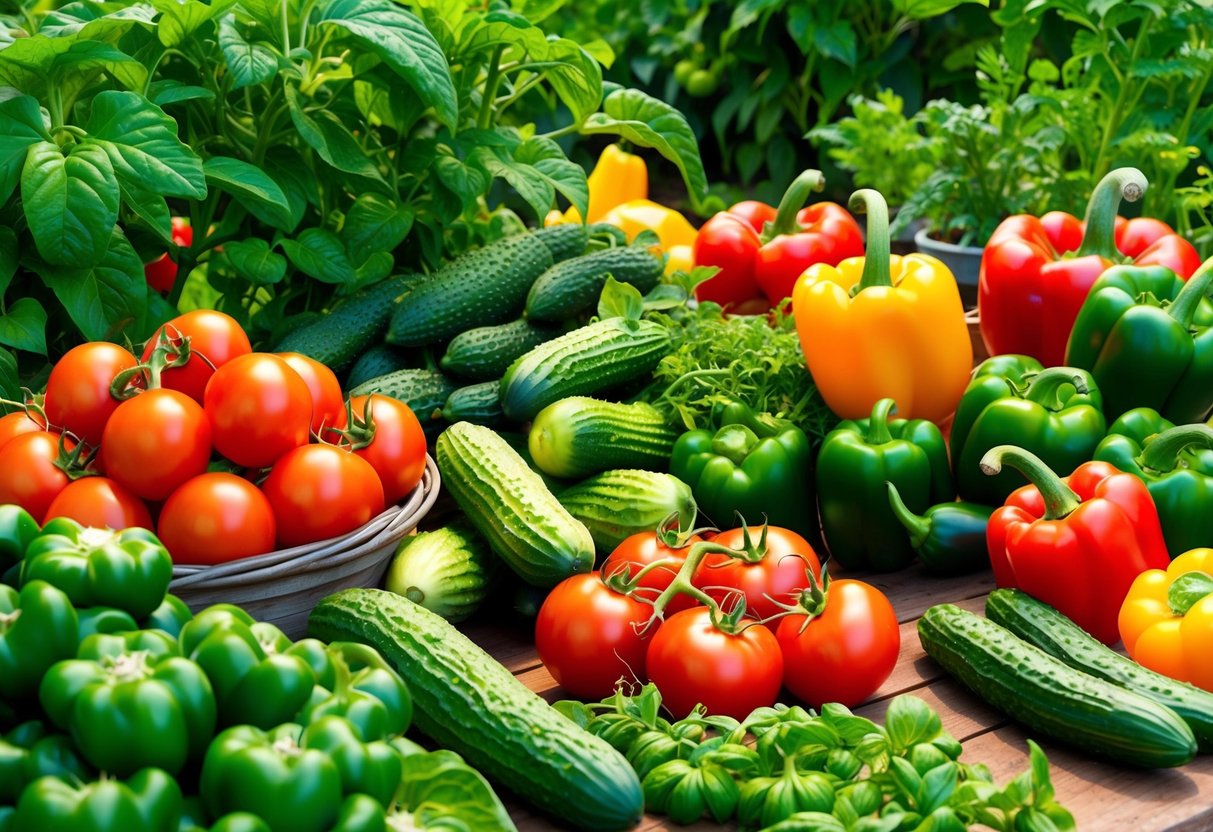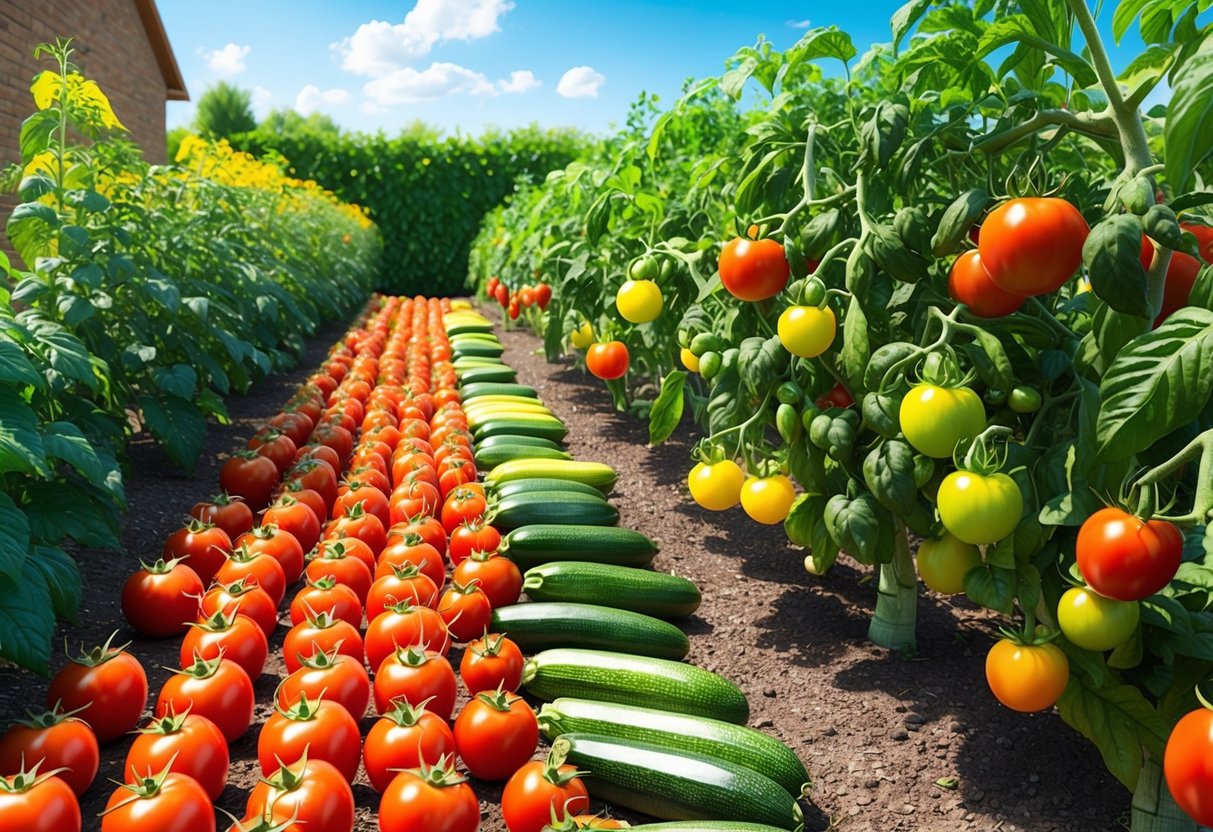
User-Friendly Fruiting Vegetables: Tomatoes to Zucchini

Home gardens often thrive with fruiting vegetables that require minimal fuss and offer high yields. Gardeners of all levels find reliable results and steady production by choosing the right varieties and following basic care guidelines.
Tomatoes and Cherry Tomatoes
Tomatoes are a classic choice for home gardeners seeking dependable harvests. Both full-size and cherry tomatoes adapt well to containers, raised beds, and in-ground plots.
Cherry tomato varieties such as Sungold or Sweet 100 are especially popular for their disease resistance and high yields. They mature quickly and can produce fruit all summer long with consistent watering and sun exposure.
Fruit set depends on at least 6-8 hours of direct sunlight daily, regular watering, and support like stakes or cages to keep vines upright. Pruning lower leaves and suckers encourages air flow and healthy growth.
For beginners, indeterminate cherry tomatoes often deliver more fruit with less labor compared to larger slicing varieties. Regular harvesting prevents fruit split and encourages ongoing production.
Tomatoes are among the easiest vegetables to grow at home.
Cucumbers, Zucchini, and Summer Squash
Cucumbers, zucchini, and summer squash set the standard for high-yield, user-friendly plants. Most varieties can be direct-sown once soil temperatures warm.
Germination occurs quickly with steady moisture. Bush and vining cucumber choices fit both small containers and garden beds.
Zucchini stands out for rapid, prolific growth. Many gardeners report more fruit than they can use after a single plant matures.
Key care tips:
- Sunlight: 6+ hours of direct light
- Water: Deep, consistent watering at the base
- Harvest: Pick zucchini when 6–8 inches long for best flavor and texture
Mulching around the base of plants helps retain moisture and keeps weeds down. These crops benefit from regular picking to encourage more flowers and fruit set.
For more on choosing high-yield beginner vegetables, visit this page about easy vegetables to grow.
Peppers and Squash Varieties
Peppers, including bell, sweet, and hot types, grow well in most home gardens. Start seeds indoors a few weeks before the last frost or buy small transplants for quicker results.
Peppers need full sun, warm soil, and space to avoid crowding. Staking larger plants increases airflow and supports heavy fruit loads.
Many beginner gardeners find that bell peppers and banana peppers are easy to maintain. They offer steady crops through the season.
Squash varieties such as crookneck, pattypan, and yellow squash are also widely grown. They produce well with little hands-on care beyond watering and weed control.
These plants often attract pollinators, which enhances fruit set and quality. Pick squash while still tender for best taste.
Companion planting with flowers or herbs can help reduce pest problems. Both peppers and squash are recognized as beginner-friendly choices for productive home vegetable gardens.
Cool-Season and Perennial Options for Consistent Yields
Cool-season vegetables and perennial crops can offer steady production without replanting each year. A well-chosen mix of these options supports high yields, reliable harvests, and less maintenance from season to season.
Onions, Garlic, and Asparagus
Onions and garlic are classic cool-season crops planted in early spring or even late fall in some climates. Both are hardy and can withstand cold soil.
These vegetables offer high yields with minimal space and consistently supply kitchens throughout the year. For best results, bulbs should be spaced evenly and planted in well-drained soil.
Asparagus is a stand-out perennial that, once established, produces spears for harvesting each spring for 15 years or more. The plant takes a couple of years to reach full production but rewards patience with abundant shoots every season.
Unlike annuals, it does not require replanting. Proper bed preparation and annual mulching are key for asparagus health and longevity.
A summary table:
| Crop | Type | Planting Season | Yield Duration | Notes |
|---|---|---|---|---|
| Onion | Biennial | Early spring | One season | Store well; grow from sets |
| Garlic | Perennial | Fall | One season | Mulch for winter protection |
| Asparagus | Perennial | Early spring | 15+ years | Needs time to establish |
Rhubarb: A Perennial Favorite
Rhubarb stands out among perennials for its tart stalks and long harvest window. Thriving in cooler climates, it emerges early in spring when few other crops are ready.
Once planted, rhubarb needs little attention beyond yearly compost application and occasional division to maintain vigor. Its thick stalks can be harvested from late spring through early summer.
Only the stalks are edible—leaves are toxic and should always be discarded. Over time, a single plant can expand to fill a generous space in the garden and supply reliable yields for up to a decade or more.
Gardeners should provide rhubarb with deep, fertile soil and a location that gets at least partial sun. With minimal care, rhubarb rewards with consistent annual harvests and can serve as an anchor plant in beds devoted to perennials and high-yield home vegetable gardening.
Herbs for Beginners: Easy Growth and High Rewards
Many herbs are well suited for new gardeners due to their resilience, compact size, and generous yields. These options often require minimal care, tolerate varying light conditions, and can enhance both garden productivity and home cooking.
Basil, Sage, and Oregano
Basil thrives in sunny spots with well-drained soil and consistent moisture. It germinates quickly and can be grown from seeds or transplants.
Harvesting leaves regularly encourages bushier growth and better yields. Fresh basil is ideal for salads, pestos, and pasta dishes.
Sage is drought-tolerant and enjoys full sun. Once established, sage needs little attention beyond occasional watering.
Its leaves are robust, perfect for roasting vegetables or seasoning meats. Pruning after flowering helps maintain bushy plants.
Oregano grows well in containers and open beds. This herb prefers a sunny location with soil that drains well.
Oregano’s spreading nature makes it easy to propagate by division or cuttings. Leaves can be harvested throughout the season for Mediterranean dishes, pizzas, and sauces.
A quick comparison of care needs:
| Herb | Sun Needs | Watering | Harvest Time |
|---|---|---|---|
| Basil | Full sun | Keep moist | 6-8 weeks |
| Sage | Full sun | Moderate/drought | After 10 weeks |
| Oregano | Full sun | Light/moderate | 8-10 weeks |